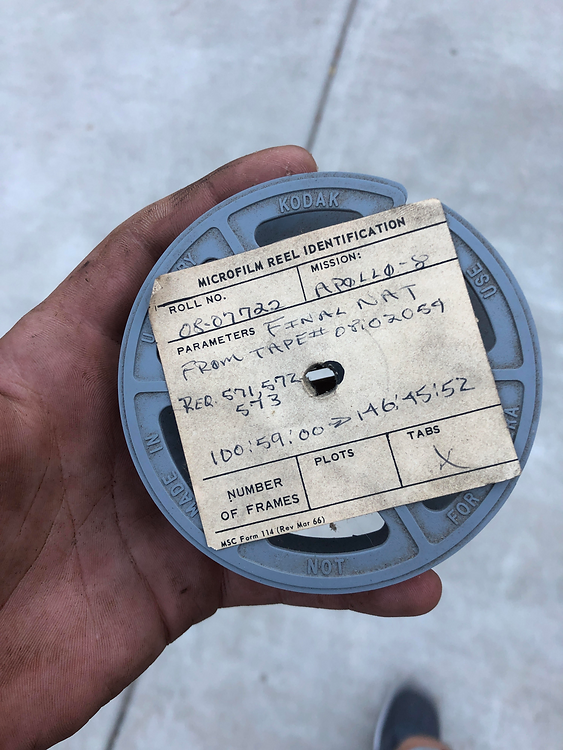
Lost Apollo 8 Trajectory Propagation
Link to microfilm data (This is a large file--311 pages--so drive cannot scan it)
Link to MATLAB script (Select the plots you want to see when prompted)
After the first Not-A-Boring competition, I was helping my team clean up our workspace which was the receiving bay of the physics building at my university. During this, I discovered a microfilm reel in the corner of the garage with a substantial layer of dust on top obscuring the identification card. When I wiped the dust off, I realized that the film had contained data pertaining to the Apollo 8 mission around the Moon. I reached out to a professor who teaches Apollo history courses at our university who get me in touch with another person who was finally able to help me look at what was on the microfilm. The contents of the film were revealed to be trajectory data from around the time of post-trans-Earth injection burn and up to re-entry. I did some further research and discovered the most likely cause of this film being left behind had been the renovations happening to the building in 1968, the same year Apollo 8 launched. My current theory is that someone helping to unload lab equipment in the high bay had set the film down (along with the screw driver and socket found next to it) and forgot about it for 50 years.
After starting my orbital dynamics course, I realized that the data on the drive would be fairly trivial to plot, so that is what I set out to do. I quickly realized, however, that traditional Optical Character Recognition programs and packages (such as tesseract in python) were not working well enough to extract the data. I thought about doing the classic machine learning number identification project trained on the microfilm data, but I realized that an easier method would be to propagate the data myself. In doing so, I managed to create a static visualization of the orbit of both the Moon and the Apollo 8 capsule and after that quickly animated their motion. I was pleased with the results as they met the inclination and rough shape expected from a moon launch originating from Kennedy Space Center and so I decided to plot a few points from the actual data to double check my work. In doing so, I found that the plotted data did not match my orbit at all, in fact, the real data took on an analemma type shape to it which I knew was impossible. This stumped me for a bit before I realized that "E-M" data I was using had in fact not been the ECI frame but instead the non-inertial Earth-Moon line reference frame. This being the case would cause an apparent retrograde motion in the orbit before returning to the line which is what I was seeing. After a few hours, I managed to create a second animation showing the rotating E-M frame overlayed on the ECI frame and the result was a near identical match between the NASA data and my orbit propagation.
During this, I reached out to NASA archives to hand over the microfilm as I have no means of proper storage in my apartment. However, after a few weeks, NASA archives determined that they "[did] not find this microfilm to be of historical significance and would not accession it into our collection". While this story sadly does not end with me discovering the long lost Apollo 8 trajectory data that NASA has been missing for 50 years, it did end with me learning many new and important things: (1) a greater understanding and working knowledge of real world orbital mechanics, (2) more practice with my programming and data analysis skills, and (3) greater interactions and connections to others who were just as interested in this project as I was and are working in an industry that fascinates me.

